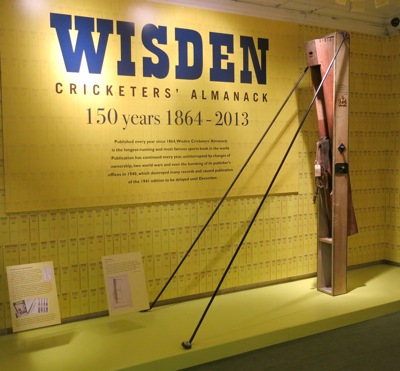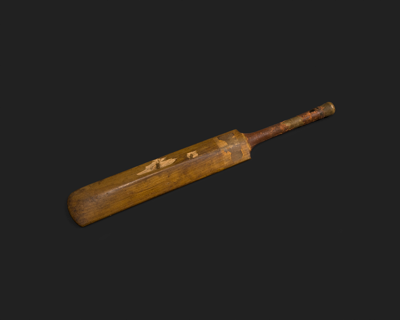
In the cricketing utopia that The Flaneur intends to help bring about the MCC cricket museum will be one of London’s most popular museums. People will charter planes from around the world to see this repository of treasures. When that time comes (and it will) the queues at Lord’s will reach to Kilburn, so why not take the chance to visit whilst you can get in without a wait?
The MCC museum originally opened as a memorial to the cricketers who died in the wars, and it begins with a section of war-related memorabilia. Over time the meaning of some pieces has been lost. Why, for example, does the collection include a Crimean cannon ball? Was it once used for fielding practice by a ruthless England coach? [Unlikely – Editor] Other pieces though old, have lost none of their meaning. A sketch attributed to Landseer makes no attempt to depict a real game. Instead it shows how cricket has long been used as a metaphor. The Duke of Wellington bats in front of a wicket made of the Three Graces who hold a banner saying A bas le tyrant. Napoleon is the cricket ball. I think we can still understand the symbolism.
I knew they were small but I hadn’t realised how small. I guess a lot of people have the same reaction on seeing the Ashes for the first time. Given as a personal gift to England captain Ivo Bligh in 1883 by his future wife, the much-loved urn is an amazingly tiny symbol of the great rivalry between England and Australia. Made of terracotta, its size makes it a perfect anti-trophy, focusing on the achievement rather than the prize.
The museum is located on two floors and includes a film theatre named after the well-loved commentator Brian Johnston. The downstairs displays are themed and include hundreds of cricketing and historical artefacts.

Photo credit: Lord’s
As you would hope there are a lot of cricket bats from different eras on display, showing the ongoing development of equipment. The most recent is a Mongoose Twenty20 bat, designed for, let’s be honest, whacking. It can be seen near the Duke of Buccleuch’s 18th century bat, much longer, narrower and slightly curved – made for a time when bowling was underarm and the aim wasn’t to hit a six off every ball. There is also an example used by one WG Grace and the bat Nassar Hussain used in his last test for England. Yet rather than the bats of these famous names the one that stands out was owned by the unknown Sgt K. Piggot. Dating from WW1 his bat was sent to France but suffered the fate of many British soldiers, and is on display with two violent shell holes in it.
Of course there are also old cricket balls, including one perfectly spherical one made from rope. Created in a prisoner of war camp it shows the lengths cricket-lovers will go to get a game. I hope the chap who painstakingly made it wasn’t out first ball.

Photo credit: Lord’s
You might think that bowling machines are a relatively recent invention, but the MCC museum houses the Catapulta, designed by expert 19th century batsman Felix. Resembling more a medieval trebuchet than sporting equipment it shows how seriously cricket has always been taken. Wisden is of course a large part of cricket culture and the museum covers the history of the thick yellow book. You will discover that John Wisden’s establishment was originally founded not just on cricket, but also cigars!
With plenty of other interesting sights, including Darren Gough’s modified boot and the finalists in the latest Cricket Sports Photography contest, a visit to the MCC museum is highly recommended for all cricketing fans. It will take longer than you think to see all the exhibits, so allow time and marvel at the different examples of cricketing history on display.

This site should display the earliest known (supposed) bat, from Normandy archaeology, which tends to show that cricket – or maybe baseball – was really invented in France. Horrors. See Museum of London…
Surely some terrible mistake. Or if it’s true, no doubt a travelling Englishman dropped his least favourite bat in France when on an early tour.